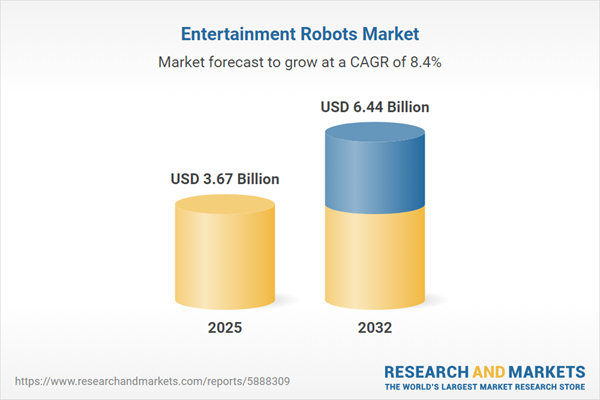Speak directly to the analyst to clarify any post sales queries you may have.
The entertainment robots market is rapidly evolving as senior executives navigate emerging technology and changing user preferences. This transformation is generating new competitive dynamics, driven by the convergence of artificial intelligence and robotics, prompting organizations to reimagine engagement strategies across diverse sectors.
Market Snapshot: Entertainment Robots Market Size and Growth
The entertainment robots market is projected to increase from USD 3.38 billion in 2024 to USD 3.67 billion in 2025, with an anticipated reach of USD 6.44 billion by 2032, reflecting a compound annual growth rate (CAGR) of 8.36%. Adoption is expanding steadily, with broad uptake in home entertainment, education, and live event sectors driving market momentum. Market leaders use a mix of established and emerging distribution strategies to address evolving demand for immersive and interactive experiences, while ensuring delivery of robotic solutions that meet the priorities of both end users and institutional buyers.
Scope & Segmentation of the Entertainment Robots Market
This report delivers an in-depth analysis to support senior decision-makers in strategic planning and resource allocation. Key market segmentation tracks the forces shaping adoption and market penetration across essential domains:
- Product Types: Includes companion robots, covering both humanoid and animal-inspired models; educational robots designed for language and STEM instruction; gaming robots with AR/VR capabilities; and toy robots that are programmable, interactive, or remotely controlled.
- Application Areas: Spans educational institutions, formal and informal training settings, domestic leisure, public events, live shows, amusement parks, themed locations, and unique entertainment venues.
- Distribution Channels: Covers direct B2B arrangements, conventional and online retail, electronics and toy specialty outlets, and third-party networks supporting global retail and wholesale delivery.
- Geographic Regions: Focused on the Americas, Europe, Middle East and Africa, and Asia-Pacific, illustrating diverse regional trends and regulatory requirements as well as evolving consumer dynamics and partnership models.
- Major Technologies: Emphasizes artificial intelligence, cloud-based learning, natural language processing, integration with AR and VR, gesture and haptic control systems, modular hardware, and the use of open-source development platforms.
- Leading Companies: Features SoftBank Robotics Holdings Corp, UBTECH Robotics Corp, Spin Master Ltd, WowWee Group Ltd, Sphero LLC, Parrot SA, Sony Group Corporation, SZ DJI Technology Co., Ltd, LG Electronics Inc, and Shenzhen Robosen Intelligent Technology Co., Ltd.
Key Takeaways for Senior Decision-Makers
- Entertainment robots are advancing hands-on, interactive learning and participation, creating new value streams across the education, enterprise, and consumer landscape by enhancing user engagement for varied audiences.
- The integration of AI functionalities, augmented reality, and virtual reality is expanding the scope of applications in entertainment, training, and public events, allowing organizations to engage wider groups and foster richer involvement.
- Manufacturers are developing modular, customizable architectures and utilizing open-source systems to accelerate product adaptation while promoting collaborative innovation throughout the industry ecosystem.
- Regional consumer patterns and distinct regulatory conditions necessitate tailored market approaches and compliance strategies, ensuring effective risk management and strong performance during global product rollouts.
- Adapting supply chain models and distribution networks is vital for maintaining operational resilience and meeting customer expectations in fluctuating business climates.
- Organizations that leverage up-to-date technology standards and build robust ecosystem partnerships can enhance customer satisfaction, sustain operational performance, and maintain differentiated market positioning.
Tariff Impact on the Entertainment Robot Industry
Anticipated tariffs in the United States for 2025 are prompting manufacturers to diversify production sources and update supply chain models. Senior leaders are emphasizing forward-thinking strategies and operational agility to manage changing regulatory environments and achieve consistent delivery across international networks.
Methodology & Data Sources
This assessment uses a comprehensive multi-method approach, including direct interviews with robotics and AI professionals, insight from industry consultants, structured survey tools, and the analysis of key industry patents and position papers. Supplementary observational research ensures alignment with operational realities and evolving market conditions.
Why This Report Matters
- Offers actionable intelligence for executives on strategic technology adoption and competitive developments shaping the entertainment robots market.
- Enables leaders to proactively assess risk and identify growth opportunities in a complex regulatory setting and shifting partnership landscape.
- Facilitates targeted investments and collaborative strategies by mapping out innovation, adoption trends, and multi-channel distribution models across the industry.
Conclusion
Embracing adaptive artificial intelligence, localized partnerships, and resilient supply chain strategies positions organizations for ongoing innovation and relevance throughout the entertainment robots sector.
Additional Product Information:
- Purchase of this report includes 1 year online access with quarterly updates.
- This report can be updated on request. Please contact our Customer Experience team using the Ask a Question widget on our website.
Table of Contents
3. Executive Summary
4. Market Overview
7. Cumulative Impact of Artificial Intelligence 2025
Samples

LOADING...
Companies Mentioned
The key companies profiled in this Entertainment Robots market report include:- SoftBank Robotics Holdings Corp
- UBTECH Robotics Corp
- Spin Master Ltd
- WowWee Group Ltd
- Sphero LLC
- Parrot SA
- Sony Group Corporation
- SZ DJI TECHNOLOGY CO., LTD
- LG Electronics Inc
- Shenzhen Robosen Intelligent Technology Co., Ltd
Table Information
| Report Attribute | Details |
|---|---|
| No. of Pages | 193 |
| Published | October 2025 |
| Forecast Period | 2025 - 2032 |
| Estimated Market Value ( USD | $ 3.67 Billion |
| Forecasted Market Value ( USD | $ 6.44 Billion |
| Compound Annual Growth Rate | 8.3% |
| Regions Covered | Global |
| No. of Companies Mentioned | 11 |









